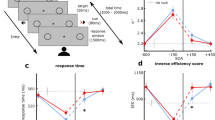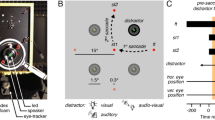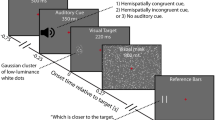Abstract
Interaction with the outside world requires the knowledge about where objects are with respect to one’s own body. Such spatial information is represented in various topographic maps in different sensory systems. From a computational point of view, however, a single, modality-invariant map of the incoming sensory signals appears to be a more efficient strategy for spatial representations. If such a single supra-modal map existed and were used for perceptual purposes, localization characteristics should be similar across modalities. Previous studies had shown mislocalization of brief visual stimuli presented in the temporal vicinity of saccadic eye-movements. Here, we tested, if such mislocalizations could also be found for auditory stimuli. We presented brief noise bursts before, during, and after visually guided saccades. Indeed, we found localization errors for these auditory stimuli. The spatio-temporal pattern of this mislocalization, however, clearly differed from the one found for visual stimuli. The spatial error also depended on the exact type of eye-movement (visually guided vs. memory guided saccades). Finally, results obtained in fixational control paradigms under different conditions suggest that auditory localization can be strongly influenced by both static and dynamic visual stimuli. Visual localization on the other hand is not influenced by distracting visual stimuli but can be inaccurate in the temporal vicinity of eye-movements. Taken together, our results argue against a single, modality-independent spatial representation of sensory signals.








Similar content being viewed by others
Notes
It should be noted that the compression index is only an indirect measure of spatial extent as it is derived from localization data of singular stimuli—subjects perception of spatial extend was not explicitly retrieved. Recently, Reeve et al. (2008) presented evidence that measures of spatial extend that are derived from single stimuli localization data may differ from direct measurements of spatial extend.
We did not study visual localization during memeory guided saccades in our setup. However, Awater and Lappe (2004) have demonstrated that the mislocalization pattern is independent of a visual saccade target.
References
Alais D, Burr D (2004) The ventriloquist effect results from near-optimal bimodal integration. Curr Biol 14:257–262
Avillac M, Deneve S, Olivier E, Pouget A, Duhamel JR (2005) Reference frames for representing visual and tactile locations in parietal cortex. Nat Neurosci 8:941–949
Awater H, Lappe M (2004) Perception of visual space at the time of pro- and anti-saccades. JNeurophysiol 91:2457–2464
Bertelson P, Aschersleben G (1998) Automatic visual bias of perceived auditory location. Psychon Bull Rev 5:482–489
Binda P, Bruno A, Burr DC, Morrone MC (2007) Fusion of visual and auditory stimuli during saccades: a Bayesian explanation for perisaccadic distortions. J Neurosci 27:8525–8532
Bischof N, Kramer E (1968) Investigations and considerations of directional perception during voluntary saccadic eye movements. Psychol Forsch 32:185–218
Bisley JW, Goldberg ME (2003) Neuronal activity in the lateral intraparietal area and spatial attention. Science 299:81–86
Bolognini N, Leo F, Passamonti C, Stein BE, Ladavas E (2007) Multisensory-mediated auditory localization. Perception 36:1477–1485
Bracewell RM, Mazzoni P, Barash S, Andersen RA (1996) Motor intention activity in the macaque’s lateral intraparietal area. II. Changes of motor plan. J Neurophysiol 76:1457–1464
Bremmer F (2005) Navigation in space—the role of the macaque ventral intraparietal area. J Physiol 566:29–35
Bremmer F, Schlack A, Duhamel JR, Graf W, Fink GR (2001a) Space coding in primate posterior parietal cortex. Neuroimage 14:S46–S51
Bremmer F, Schlack A, Shah NJ, Zafiris O, Kubischik M, Hoffmann K-P, Zilles K, Fink GR (2001b) Polymodal motion processing in posterior parietal and premotor cortex: a human fMRI study strongly implies equivalencies between humans and monkeys. Neuron 29:287–296
Bremmer F, Klam F, Duhamel J-R, Ben Hamed S, Graf W (2002) Visual-vestibular interactive responses in the macaque ventral intraparietal area (VIP). Eur J Neurosci 16:1569–1586
Caclin A, Soto-Faraco S, Kingstone A, Spence C (2002) Tactile “capture” of audition. Percept Psychophys 64:616–630
Cai RH, Pouget A, Schlag-Rey M, Schlag J (1997) Perceived geometrical relationships affected by eye-movement signals. Nature 386:601–604
Carrasco M, Ling S, Read S (2004) Attention alters appearance. Nat Neurosci 7:308–313
Colby CL, Duhamel JR, Goldberg ME (1993) Ventral intraparietal area of the macaque: anatomic location and visual response properties. J Neurophysiol 69:902–914
Deubel H (2004) Localization of targets across saccades: Role of landmark objects. Vis Cogn 11:173–202
Duhamel JR, Bremmer F, BenHamed S, Graf W (1997) Spatial invariance of visual receptive fields in parietal cortex neurons. Nature 389:845–848
Getzmann S (2002) The effect of eye position and background noise on vertical sound localization. Hear Res 169:130–139
Groh JM, Trause AS, Underhill AM, Clark KR, Inati S (2001) Eye position influences auditory responses in primate inferior colliculus. Neuron 29:509–518
Honda H (1989) Perceptual localization of visual stimuli flashed during saccades. Percept Psychophys 45:162–174
Jay MF, Sparks DL (1984) Auditory receptive fields in primate superior colliculus shift with changes in eye position. Nature 309:345–347
Kaas JH, Nelson RJ, Sur M, Lin CS, Merzenich MM (1979) Multiple representations of the body within the primary somatosensory cortex of primates. Science 204:521–523
Kaiser M, Lappe M (2004) Perisaccadic mislocalization orthogonal to saccade direction. Neuron 41:293–300
Kaminiarz A, Krekelberg B, Bremmer F (2007) Localization of visual targets during optokinetic eye movements. Vision Res 47:869–878
Klingenhoefer S, Bremmer F (2004) Perisaccadic mislocalization of auditory targets. In: Ilg UJ, Bülthoff HH, Mallot HA (eds) Dynamic perception. AKA Akad Verlag, Berlin, pp 65–70
Lappe M, Awater H, Krekelberg B (2000) Postsaccadic visual references generate presaccadic compression of space. Nature 403:892–895
Lewald J (1998) The effect of gaze eccentricity on perceived sound direction and its relation to visual localization. Hear Res 115:206–216
Lewald J, Ehrenstein WH (1996) The effect of eye position on auditory lateralization. Exp Brain Res 108:473–485
Matin L, Pearce DG (1965) Visual perception of direction for stimuli flashed during voluntary saccadic eye movements. Science 148:1485–1488
Razavi B, O’Neill WE, Paige GD (2007) Auditory spatial perception dynamically realigns with changing eye position. J Neurosci 27:10249–10258
Reeve P, Clark JJ, O’Regan JK (2008) Convergent localization near saccades without equivalent compression of perceived separation. J Vis 8:1–19
Ross J, Morrone MC, Burr DC (1997) Compression of visual space before saccades. Nature 386:598–601
Rowland B, Stanford T, Stein B (2007) A Bayesian model unifies multisensory spatial localization with the physiological properties of the superior colliculus. Exp Brain Res 180:153–161
Schlack A, Hoffmann KP, Bremmer F (2002) Interaction of linear vestibular and visual stimulation in the macaque ventral intraparietal area (VIP). Eur J Neurosci 16:1877–1886
Schlack A, Sterbing-D’Angelo SJ, Hartung K, Hoffmann KP, Bremmer F (2005) Multisensory space representations in the macaque ventral intraparietal area. J Neurosci 25:4616–4625
van Beers RJ, Wolpert DM, Haggard P (2001) Sensorimotor integration compensates for visual localization errors during smooth pursuit eye movements. J Neurophysiol 85:1914–1922
van der Heijden AH, van der Geest JN, de Leeuw F, Krikke K, Müsseler J (1999) Sources of position-perception error for small isolated targets. Psychol Res 62:20–35
Wandell BA, Dumoulin SO, Brewer AA (2007) Visual field maps in human cortex. Neuron 56:366–383
Werner-Reiss U, Kelly KA, Trause AS, Underhill AM, Groh JM (2003) Eye-position affects activity in primary auditory cortex of primates. Curr Biol 13:554–562
Woods TM, Lopez SE, Long JH, Rahman JE, Recanzone GH (2006) Effects of stimulus azimuth and intensity on the single-neuron activity in the auditory cortex of the alert macaque monkey. J Neurophysiol 96:3323–3337
Acknowledgments
This work was supported by Deutsche Forschungsgemeinschaft (GRK-885-NeuroAct and FOR-560) and the EU (FP6-043236: MEMORY).
Author information
Authors and Affiliations
Corresponding author
Electronic supplementary material
Below is the link to the electronic supplementary material.
Rights and permissions
About this article
Cite this article
Klingenhoefer, S., Bremmer, F. Perisaccadic localization of auditory stimuli. Exp Brain Res 198, 411–423 (2009). https://doi.org/10.1007/s00221-009-1869-3
Received:
Accepted:
Published:
Issue Date:
DOI: https://doi.org/10.1007/s00221-009-1869-3




